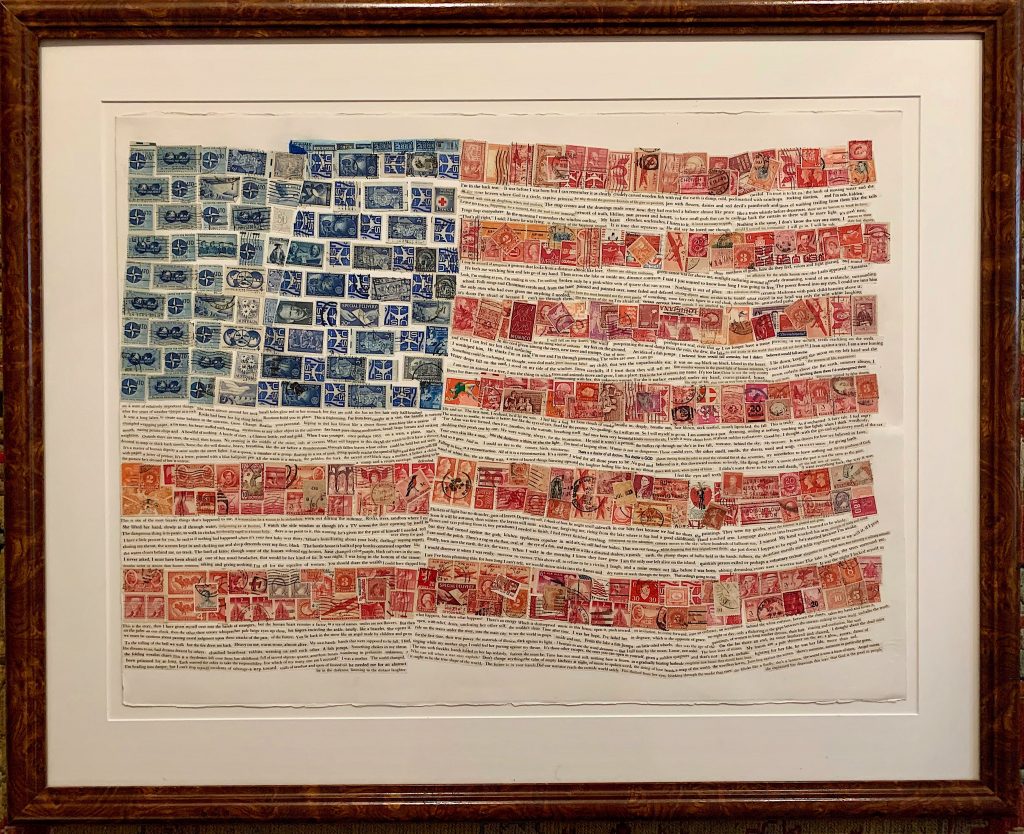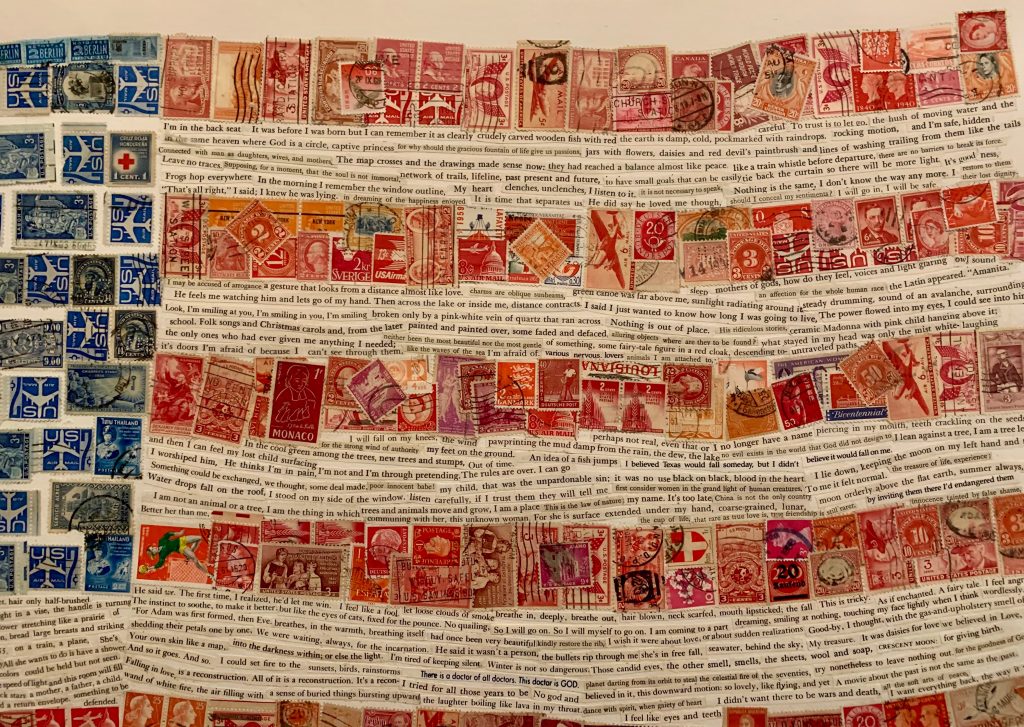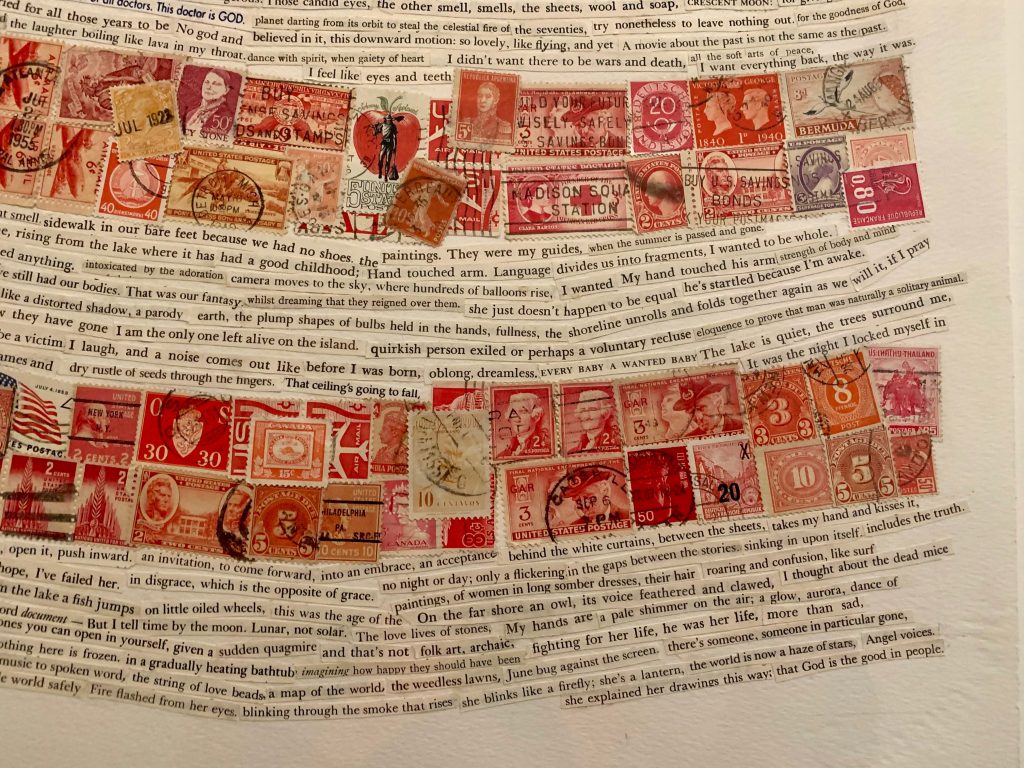Art that Speaks in Troubled Times
Beloved piece of feminist art goes on auction this week
by Louise O’Neill Vance
July 7, 2022
People who buy a work of art for their personal enjoyment know the feeling: it’s a jolt, a magnetic attraction, a pull that overtakes you when you come face to face with the piece for the first time. The artist may be well known, or unknown, or regionally-known—doesn’t matter. It’s their creation that lures you.
I felt that jolt the moment I saw Barbara Price’s Not an Object of Worship, a meticulously constructed, intricate collage of slivered text and timeworn stamps in the shape of an altered, but unmistakable, American flag. Its theme, the one that permeates Margaret Atwood’s dystopian novel The Handmaid’s Tale from which its words originate, can be summed up in a single word: resistance. But in the artist’s hands, Atwood’s story is infused with countless new meanings in a deconstruction that’s both personal and open-ended.

I first discovered the flag collage while visiting Price at her home outside Saratoga Springs, New York in the summer of 1993. The large framed work commanded her living room; its majestic composition of text and images drew me in instantly. The flag has the “wrong” number of stripes––one of many things I love about it––making it a subtle re-appropriation of America’s emblem. Its title is based on a declaration by artist Richard Serra in response to the censorship of one of his works. Frustrated by what he called “mandatory patriotism,” Serra declared, “The American Flag is not an object of worship.” The phrase stuck with Price and she adopted it for this piece.
Not an Object of Worship graced the walls of our San Francisco home for two decades, during which time I wrote and directed five television and film projects serving women and girls. It became a talisman of sorts. For starters, Atwood commands language as few others can; her descriptions are always muscular, often poetic. Each night before bed, I’d stand in front of the piece, eyes closed, and randomly point to a place on the glass to see where my finger landed. Without fail, the phrase that appeared spoke to something front and center in my life. It was throwing the I Ching in a modern, feminist context. And that, strangely enough, brought me comfort as I traversed the rough terrain of being an indie filmmaker and feminist activist.
“The text is naturally fragmented and stream-of-consciousness,” Price explains. “Yet because I was delving deeply into—literally dissecting—The Handmaid’s Tale, the lines are from a woman’s (Offred/Barbara’s) perspective. They recount struggles for emotional connection combined with burgeoning personal autonomy. I was teaching myself and remaking myself as I worked; I would sliver and reposition, moving tiny bits of paper around with the point of a long pin. I would place, consider, glue, and repeat the process. A story was unfolding, but without me having any idea where it was taking me. These are subconscious wanderings, recollections and reconstructions.”

In 1998, I took a leap of faith and launched an independent film project exploring women’s rights: past, present and future. Without institutional funding, my team and I had to raise the production budget through individual donations and grants. The documentary, Seneca Falls, follows the journey of nine teenage girls from the San Francisco Bay Area to an international celebration marking the birth of women’s rights in America. It took a decade to complete, but along the way, we met women and men who believed passionately in the film and in gender equity, and generously joined the effort. In 2010, Seneca Falls premiered on PBS stations across the U.S., and since then, has made its way into libraries and museums and institutions of higher learning around the world. It has been the centerpiece of countless International Women’s Day events, and throughout its labyrinthine journey, one line in the flag collage jumped out at me—nearly every night:
It was a long labor. To create some balance in the universe, Grow.
After Seneca Falls was released, fresh lines jumped out when I stood before the collage: that rare as true love is, true friendship is rarer.
And often:Look, I’m smiling at you, I’m smiling in you, I’m smiling.
A pregnant friend opened her eyes in front of the piece to see this: EVERY BABY A WANTED BABY

And the collage’s stunning final words: she explained her drawings this way: that God is the good in people.
This month, in the wake of the U.S. Supreme Court’s ruling to overturn Roe v. Wade, Not an Object of Worship holds new and urgent relevance. In Atwood’s novel and the television drama based on it, an extremist religious group has staged a political coup, and with mindless cruelty, rolled back the gains women had made towards social, civil and legal equality––most strikingly, agency over their bodies. When Atwood wrote her story in 1985, she did so amid a backlash against women’s rights and opportunities already underway. But today, with the passage of state laws that diminish women’s reproductive freedom and endanger their health, the pendulum is swinging backwards to shocking new heights, and The Handmaid’s Tale now sits squarely on the cultural scene as a manifestation of the ultimate nightmare for women.
Since I moved to Ireland in 2017, Not an Object of Worship has been lovingly cared for by a close friend in California. Today, as the latest round of feminist activism gears up to protect women’s lives and as I turn my attention to environmental activism in my adopted country of Ireland, it’s time to pass on this uniquely powerful artwork to new eyes and new hearts. I bought the piece because it spoke to me, gave me strength, opened my mind to new possibilities. I’m passing it on in the hopes that it will do the same for others during these perilous times for America.
Not an Object of Worship will be placed on auction on eBay for ten days beginning at 5:00 pm PDT, July 7, 2022. The piece measures 38″ long by 31″ wide in a walnut wood frame, and will be shipped from San Francisco.
A portion of the proceeds will be donated to the Global Fund for Women.
To view the auction, please visit our listing on eBay.
Learn more about the artist and her work at www.barbaraprice.net.
To stream the documentary Seneca Falls, visit senecafalls.vhx.tv.
Please share widely. Thank you.

